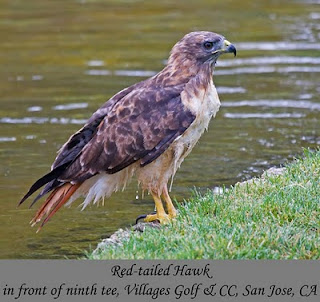
This week we look at part four of USGA agronomist, Pat Gross’ December 2010 report on the greens at the Villages. This week Pat's report starts getting to the real issue: Improving the firmness of the greens.
ENHANCING FIRMNESS
Cultivation - Core aeration and surface cultivation of the greens should be a primary focus of your ongoing management programs as a method to physically remove excess thatch and organic matter. The following recommendations were made during the visit regarding recommended cultivation programs for the coming year:
Continue with the current program of deep aeration during the month of April using ?-inch to ¾-inch diameter tines followed by sand topdressing to fill the holes completely to the surface.
As part of the April treatment, consider testing the Graden™ Sand Injection machine, which is a heavy-duty vertical mowing machine that removes thatch and injects sand directly into the grooves. You may wish to evaluate this treatment on a portion of the practice putting green and observe the impact on surface firmness and the time necessary for turf recovery. The combination of aeration and sand injection was completed in September at Torrey Pines Golf Course, and the protocol for this operation is attached to this report as a further reference.
Continue the current practice of venting the greens at monthly intervals from May through September. This can be done by using small diameter 1/4-inch solid tines, or a slicing machine, such as the PlanetAir™.
Although most courses schedule core aeration and sand topdressing in the fall, this practice has been suspended for many years at the Villages due to concerns regarding rapid blight disease. As an alternative, you may wish to evaluate the DryJect™ as an option for aerating the greens in late September. This is a contract service using a specialized machine that injects a slurry of sand and water into the greens under high pressure. Several superintendents in the San Francisco Bay area have reported good results with this procedure and slightly less time for turf recovery.
ENHANCING FIRMNESS
Cultivation - Core aeration and surface cultivation of the greens should be a primary focus of your ongoing management programs as a method to physically remove excess thatch and organic matter. The following recommendations were made during the visit regarding recommended cultivation programs for the coming year:
Continue with the current program of deep aeration during the month of April using ?-inch to ¾-inch diameter tines followed by sand topdressing to fill the holes completely to the surface.
As part of the April treatment, consider testing the Graden™ Sand Injection machine, which is a heavy-duty vertical mowing machine that removes thatch and injects sand directly into the grooves. You may wish to evaluate this treatment on a portion of the practice putting green and observe the impact on surface firmness and the time necessary for turf recovery. The combination of aeration and sand injection was completed in September at Torrey Pines Golf Course, and the protocol for this operation is attached to this report as a further reference.
Continue the current practice of venting the greens at monthly intervals from May through September. This can be done by using small diameter 1/4-inch solid tines, or a slicing machine, such as the PlanetAir™.
Although most courses schedule core aeration and sand topdressing in the fall, this practice has been suspended for many years at the Villages due to concerns regarding rapid blight disease. As an alternative, you may wish to evaluate the DryJect™ as an option for aerating the greens in late September. This is a contract service using a specialized machine that injects a slurry of sand and water into the greens under high pressure. Several superintendents in the San Francisco Bay area have reported good results with this procedure and slightly less time for turf recovery.







